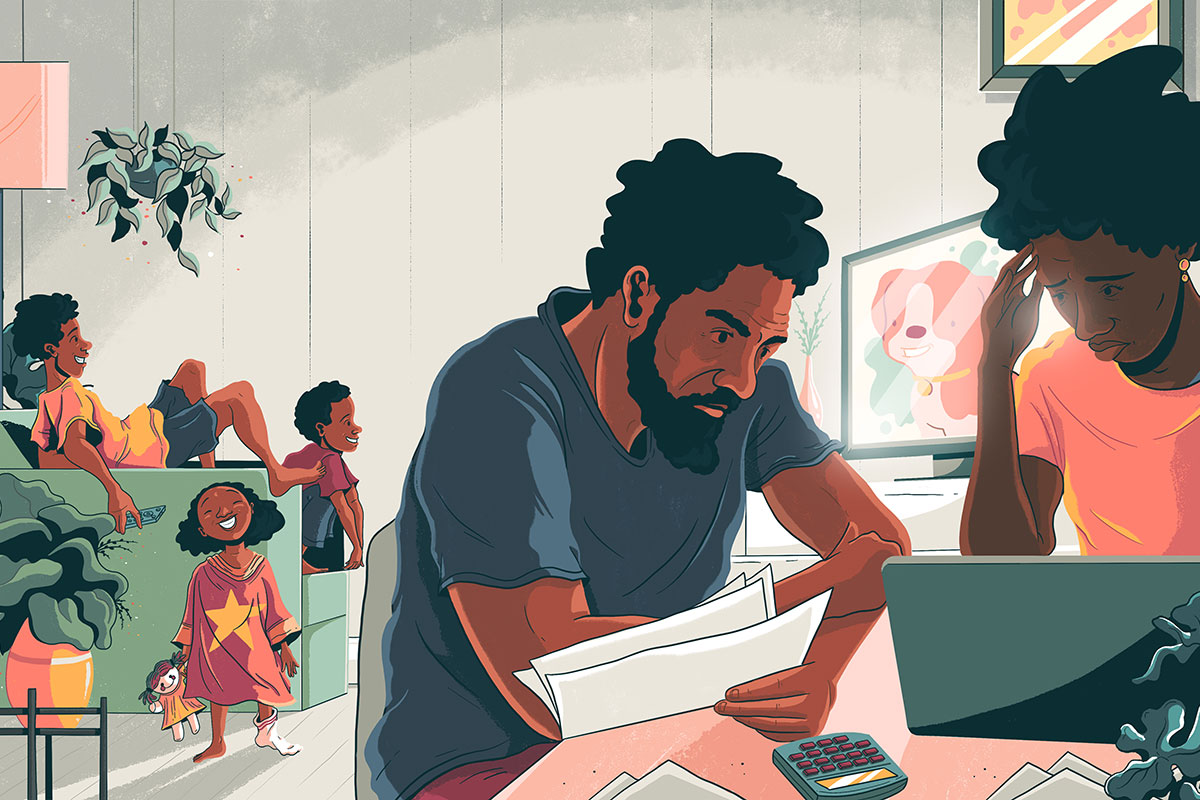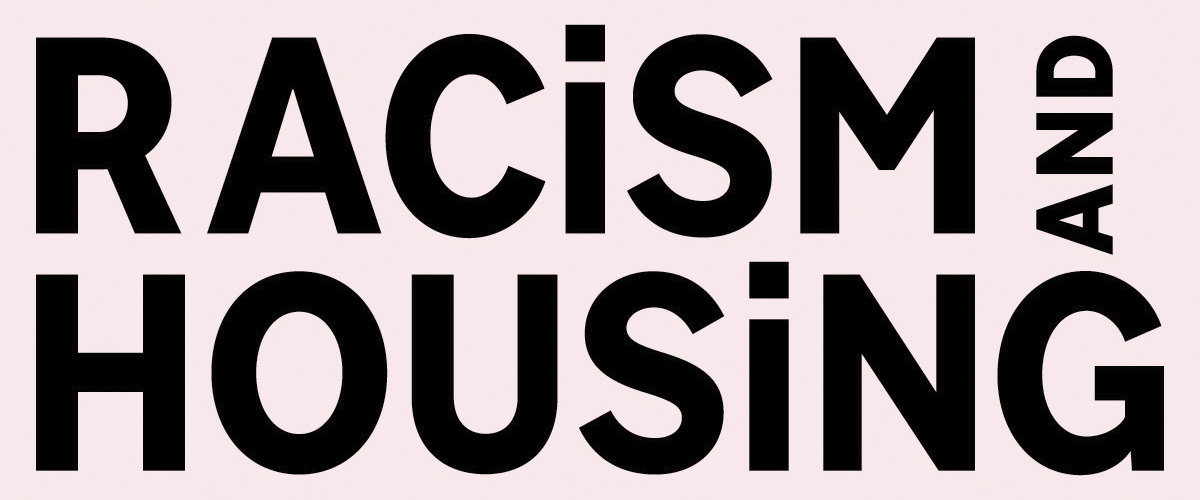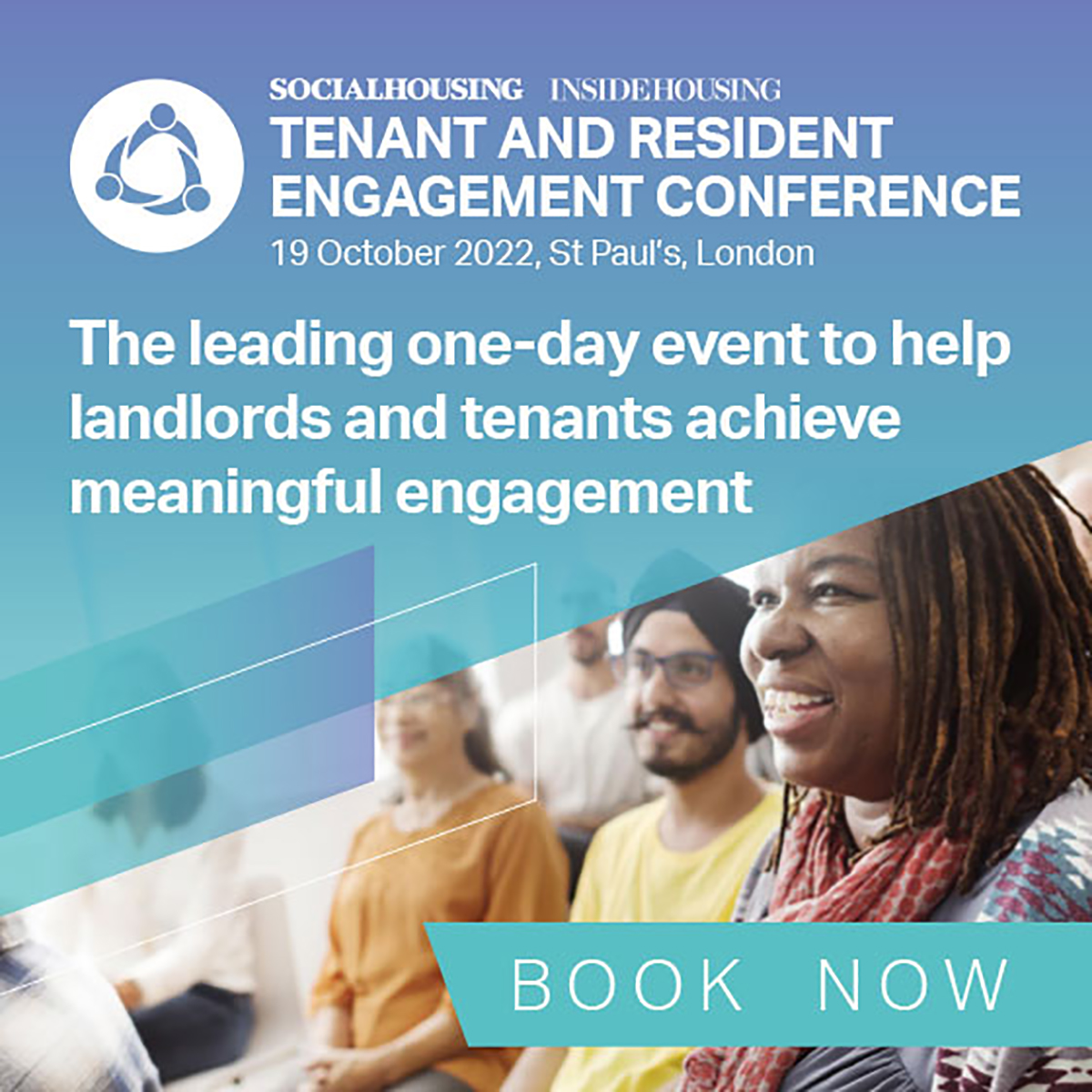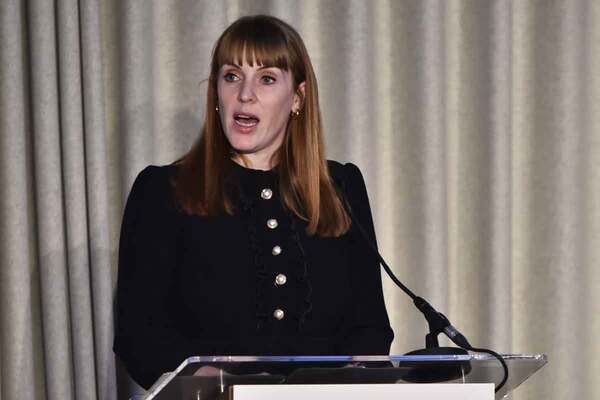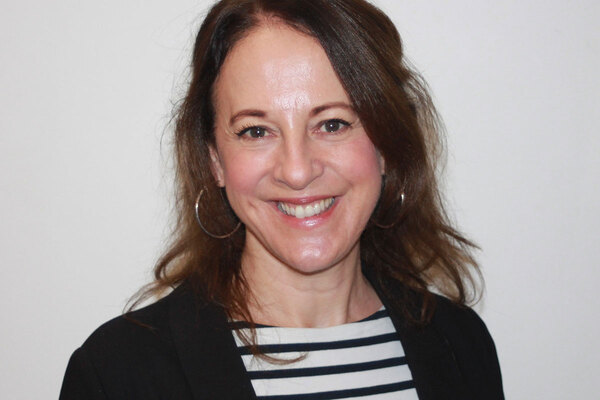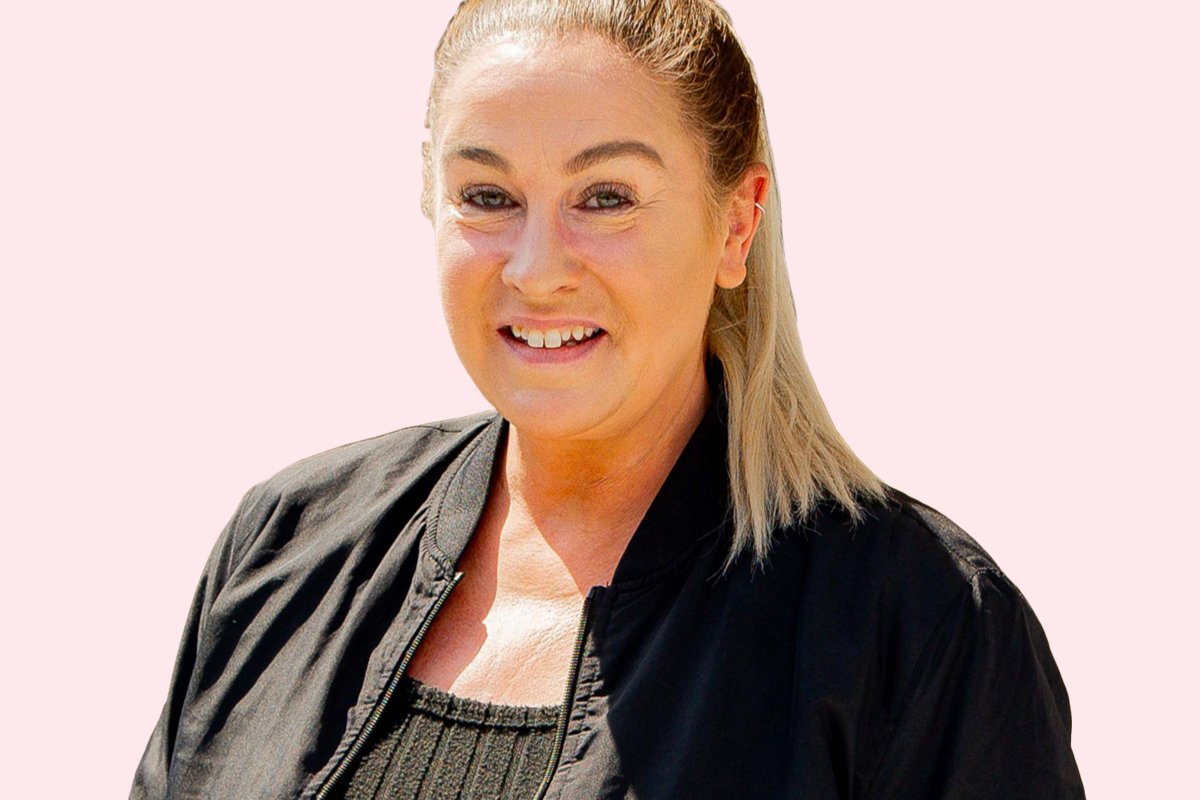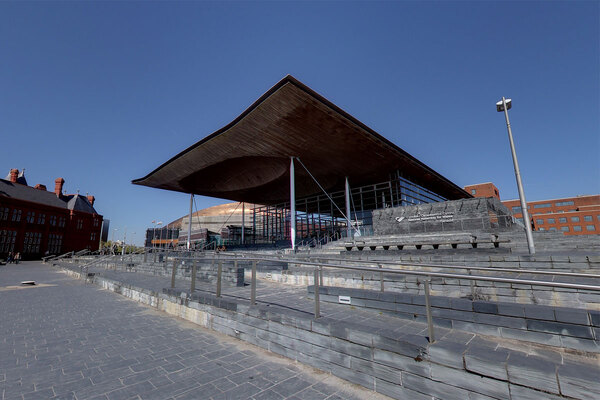You are viewing 1 of your 1 free articles
Race and the cost of living crisis: the impact on social housing tenants

Soaring prices are threatening to cause the biggest drop in living standards in decades – but, data suggests, Black and ethnic minority residents of social housing may be particularly vulnerable. Alex Turner reports. Illustration by Luke Brookes
Soaring food, energy and fuel prices are hitting many citizens’ pockets with devastating force.
Food banks have been warning of rising demand, including from people who had not previously considered using one. And the annual cap on energy prices is expected to go up to £2,800 this autumn, putting millions of people at risk of fuel poverty.
While chancellor Rishi Sunak’s recent announcement of a boost to benefits and an energy bill rebate have delivered some temporary respite, emerging analysis is reinforcing one of the pandemic’s key lessons: that money pressures do not hit all ethnic groups equally.
“People from Black, Asian and minority ethic backgrounds tend to be younger and in larger households, meaning their cost of living is higher”
In May, the New Economics Foundation (NEF) thinktank published analysis warning that Black, Asian and other ethnic minority households will experience an average increase in the cost of living 1.6 times greater than their white counterparts.
The NEF’s analysis drew on data from the government’s annual Family Resources Survey (see box), published late in March, which found that Black, Bangladeshi and Pakistani households are disproportionately likely to face “low” or “very low” food security.
Black and Bangladeshi people are significantly over-represented among social renters, who the Family Resources Survey found were more than twice as likely as private tenants – and more than 13 times as likely as homeowners – to face low or very low food security.
Social tenants have, of course, faced extra squeezes of late. Most English landlords opted to raise rents in April by a maximum-permitted 4.1% and some service charges rose sharply, prompting protests.
These figures should raise alarms, but do they add up to a conclusion that social renters of some ethnicities face a perfect cost of living storm – and if so, why?
“While there has been a significant rise in employment of Black, Asian and minority ethnic people since 2002, much of this has been precarious employment, which also tends to be less well paid, so the cost of living crisis is very worrying”
“There’s a couple of reasons why BAME [Black, Asian and minority ethnic] households are more affected than white households,” says Sam Tims, a co-author of the recent NEF report. “First, people from BAME backgrounds tend to be younger and in larger households, meaning their cost of living is higher.”
Benefits policy has had an impact too, he continues, particularly the “two-child limit” restriction on Universal Credit, and the benefit cap. These policies, he says, “have disproportionately impacted BAME households, who also have lower incomes”.
Jabeer Butt, chief executive of the Race Equality Foundation, has also criticised the government for moving too slowly to mitigate the cost of living crisis – and for failing to appreciate that doing so will deepen race inequality.
“While there has been a significant rise in employment of Black, Asian and minority ethnic people since 2002, much of this has been precarious employment, which also tends to be less well paid, so the cost of living crisis is very worrying,” he says.
Mr Butt points to briefings his organisation published last year, which suggest that people from BAME groups were more likely to be struggling with bills as a result of the pandemic, and to be in rent arrears. The analysis found Bangladeshi, Pakistani and Black African people were particularly likely to be behind on bills and rent – and that twice as many social tenants as private renters were in debt to their landlord.
Last year, academics from the University of Bristol evaluated a range of intersecting factors – not only around ethnicity, but also gender, age and disability – that fuel inequalities in how people are affected by poverty.
Their study found Bangladeshi and Pakistani households experienced the highest poverty rates, and were most likely to be paid less than the living wage, while Black households had the highest rate of unemployment. Compounding pressure on people’s incomes were ‘poverty premiums’ around household spending – notably on energy.
People on low and insecure incomes are often forced into pricier arrangements, such as prepayment meters or paying on receipt of bills, because they have too little regular income to set up direct debits. Social renting households were the biggest users of prepayment meters, researchers found.
Race, tenure and food insecurity
In Inside Housing’s Racism and Housing series, we have highlighted datasets that reveal inequalities around the experience of housing, such as people’s likelihood of living in a damp home or being allocated a social rented property.
While the rapid onset of the cost of living crisis means there is less directly applicable information to draw on, the regular Family Resources Survey, which studies income levels on behalf of the Department for Work and Pensions, offers some troubling insights.
Since 2019, the survey has asked questions on food security, in other words whether households have sufficient food to facilitate an active and healthy lifestyle.
Across all ethnicities, 7% of the population was found to be food insecure in the last data collection, in 2021. By comparison, 21% of Black households, 17% of Pakistani households and 12% of Bangladeshi households lacked food security.
The survey suggested stark disparities based on housing tenure, especially among working-age households – 9% across all housing types experienced food insecurity. Among social renting households of working age, the figure was 27%, compared with 2% of owner-occupiers and 12% of private renters. It records 43% of Black households and 38% of Bangladeshi ones as occupying social homes, compared with 17% of the general population.
The survey emphasises its findings should be treated with caution, especially given lower rates of participation during COVID-19. But the findings give cause for concern around how ethnicity and housing tenure combine to affect people’s chances of experiencing food poverty.
“People who are on prepayment meters are also least likely to have switched [providers or to] have fixed their tariffs,” says lead researcher Sara Davies.
‘Massive, massive’ strain
How do such findings compare with expert viewpoints from within the housing sector?
Bashir Uddin, chief executive of Bangla Housing Association, which manages almost 300 homes in London, points out that government financial aid during COVID-19 failed to reach many people in local Bangladeshi communities, who had previously been hit by benefit cuts.
“There are lots of ‘hidden’ people who did not qualify for furlough and suffered over the pandemic, losing jobs and income,” he says.
“The legacy of the pandemic is still with us, and now rising prices are hitting people hard.”
It is a perspective shared by Ulfat Hussain, deputy chief executive of Bradford’s Manningham Housing Association. He says the organisation’s benefits advisor has “never been busier”, despite the recent past being dominated by years of austerity. He highlights the impact of existing health inequalities on some tenants’ household budgets.
Diabetes and heart disease, for instance, are more prevalent in people of South Asian descent, whom both Manningham and Bangla were set up to serve. “Only being able to eat certain kinds of [healthier] food comes at a cost,” says Mr Hussain. “Health conditions also often mean you need to use your heating more.”
While much of Manningham’s 1,400-strong stock is more energy efficient and in better condition than the privately owned Victorian terraces that dominate Bradford, Mr Hussain says he expects to see “massive, massive” strain on residents as energy use rises in the autumn.
What can landlords do?
In Manchester, Cym D’Souza, chief executive of 1,000-home Arawak Walton, the North West’s largest Black and minority ethnic-led housing association, strikes a slightly more nuanced tone.
While emphasising that many tenants are living “effectively below the breadline”, she says she is not aware of people’s situations spiralling out of control, at this stage, as rapidly as many at her organisation feared. “We have been pointing more people in the direction of food banks, but haven’t seen the [level of additional hardship] we thought we might,” Ms D’Souza says.
In numbers
7%
Percentage of the population that is food insecure
21%
Percentage of Black households who are food insecure
27%
Percentage of food-insecure social renting households
That said, she adds, “We’re coming into the summer months, so a big fear for us is people not putting the heating back on when winter starts,” leading to condensation and damp. Previous Inside Housing analysis has highlighted that these problems are excessively experienced by many ethnic minority communities.
Ms D’Souza, Mr Uddin and Mr Hussain say their organisations have raised rents by the maximum Consumer Price Index plus 1% as well. They point to rising costs they face in areas such as repairs and maintenance, including retrofitting homes.
So if they do not freeze rents, what can landlords do for residents falling into negative household budgets as a result of rising living costs? And what steps are they taking to mitigate inequalities?
Inside Housing put these questions to 20 large housing associations and stock-holding local authorities serving ethnically diverse urban areas. Fewer than half responded, and many of those that did directed us to general work they have done around assisting people on low incomes, or told us they were just beginning to assess the impact of rising living costs.
One exception, Peabody, is scrutinising data pooled from its regular Peabody Index survey, which tracks challenges in employment, pay and living standards facing social housing tenants in London. The 67,000-home landlord is pulling together information from five snap surveys during COVID-19 lockdowns, and two larger exercises in September 2021 and January 2022.
“[We need to ask]: how do we level up for communities where disparities are not getting better or are widening even further?”
“Our initial analysis of multiple Peabody Index surveys suggests Black and ethnic minority residents are experiencing higher rates of insecure employment, with increasing numbers saying their finances are in a ‘desperate’ situation compared with white residents,” says Stephen Burns, Peabody’s executive director for care, supported housing and inclusion.
“This is particularly the case in more recent data, suggesting people from Black and other ethnic minority groups are more likely than white groups to have seen their finances worsen since the economy opened up and the cost of living crisis began to bite,” he adds.
Leaders of community-based, specialist Black and minority ethnic housing associations interviewed for this piece argue they have more involved relationships with tenants, who feel more comfortable discussing problems at an early stage. Mr Uddin suggests some larger landlords would do well to “rethink their strategies” in terms of ensuring staff proactively make themselves available to all groups of people they serve.
Both Mr Uddin and Ms D’Souza highlight the post-COVID-19 recruitment struggles many employers are facing as creating opportunities to support residents in gaining skills to access jobs they may previously have found unattainable. “It’s definitely a candidate’s market at the moment,” observes Ms D’Souza.
Landlords should be lobbying government not only around areas such as reversing benefit cuts, but in terms of deepening the scope of its levelling-up agenda beyond regional inequalities, adds Mr Hussain.
“[It’s] not just about putting money into [tenants’] pockets, but helping them increase their income through employment. [We need to ask]: how do we level up for communities where disparities are not getting better or are widening even further?”
Racism and Housing series
Inside Housing’s Racism and Housing series aims to investigate how race inequality and racism interact with and impact on housing – for tenants, for staff working in housing, and for organisations. It has been launched a year since George Floyd’s murder prompted a huge global wave of Black Lives Matter activism.
We will be publishing monthly investigations that look at racism, race and housing, both in terms of what is going wrong, and what actions that sector is taking to address this.
If you have an idea for a story relating to this campaign, please contact deputy editor (features) Jess McCabe, at jess.mccabe@insidehousing.co.uk.
The stories published so far include:
‘We had to abandon everything’: the story of Chan Kataria and the flight of the Ugandan Asians
Race and the cost of living crisis: the impact on social housing tenants
How to create an inclusive housing association: a conversation with Bal Kang
How Cardiff landlords are tackling under-representation
Why has diversity progress stalled?
How racism impacts homeless people
How planning is failing to address race inequality in housing
Race and allocation: who are the new tenants getting social housing, and is it equitable?
How to increase representation of ethnic minorities in senior roles
How race impacts on people’s likelihood of living in a damp home or experiencing fuel poverty
Sign up for the IH long read bulletin
Already have an account? Click here to manage your newsletters
Sign up to the Tenant and Resident Engagement Conference
Join us at this leading one-day event designed to help landlords and tenants achieve meaningful engagement following the Social Housing White Paper sector reforms, covering culture change, co-production and how to engage tenants on climate change, building safety, disrepair and more.
There is a free tenant place for every delegate pass booked by a landlord.
To view the agenda and book your delegate pass, click here.
